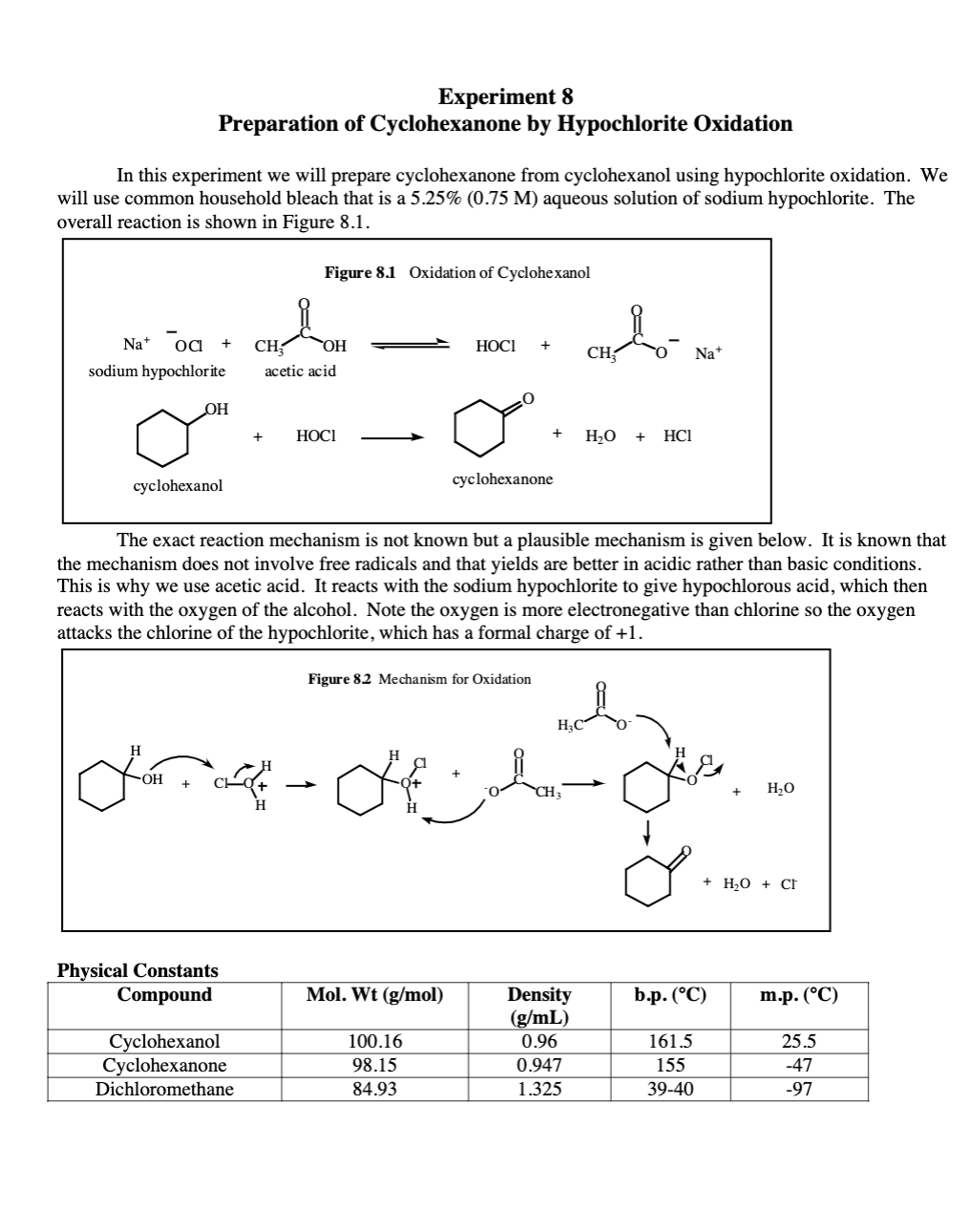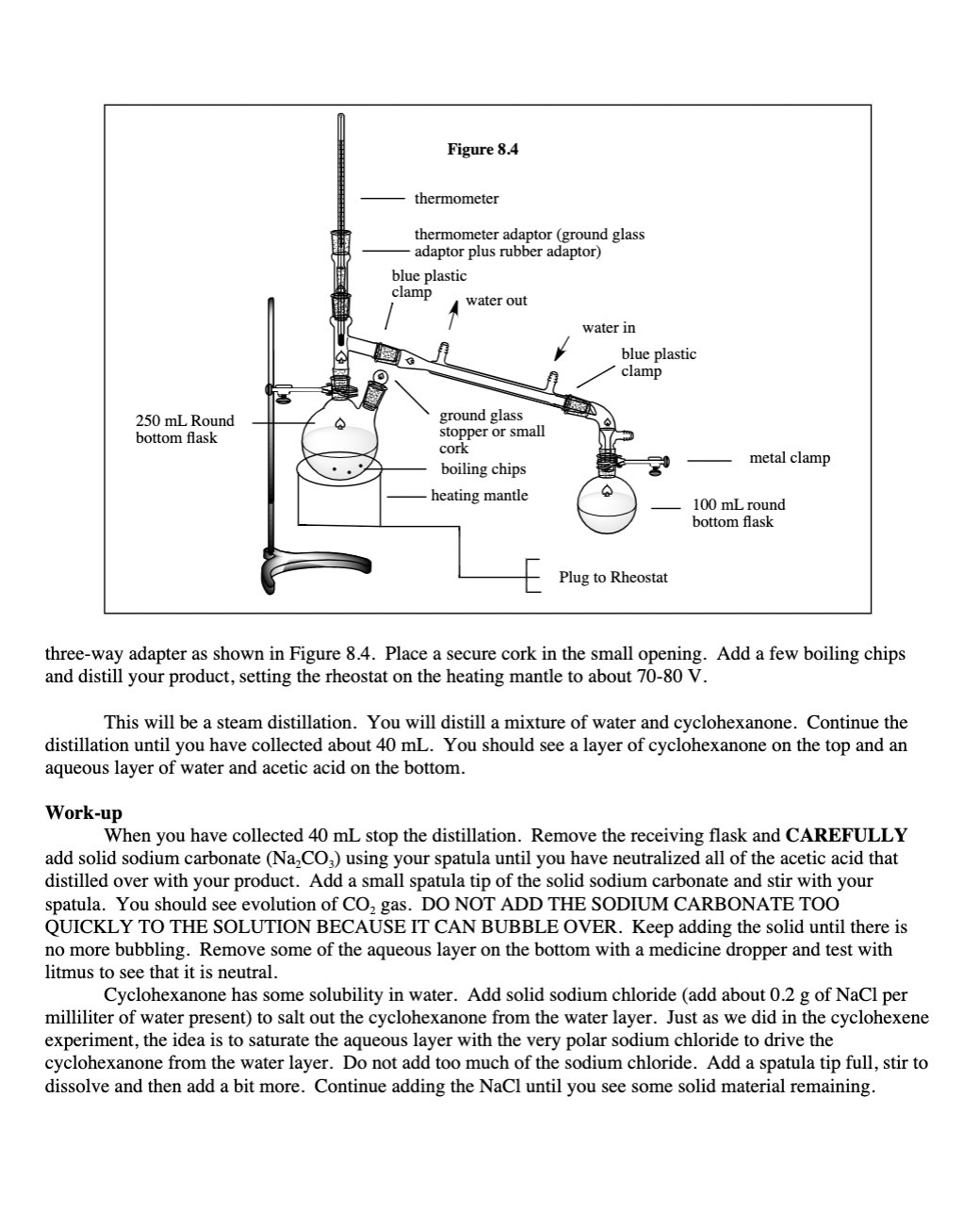Experiment 8 Preparation of Cyclohexanone by Hypochlorite Oxidation In this experiment we will prepare cyclohexanone from cyclohexanol using hypochlorite oxidation. We will use common household bleach that is a 5.25% (0.75 M) aqueous solution of sodium hypochlorite. The overall reaction is shown in Figure 8.1. Figure 8.1 Oxidation of Cyclohexanol Na* OCI CH; HOCI CH: Na* sodium hypochlorite acetic acid OH HOCI H2O HCI cyclohexanol cyclohexanone The exact reaction mechanism is not known but a plausible mechanism is given below. It is known that the mechanism does not involve free radicals and that yields are better in acidic rather than basic conditions. This is why we use acetic acid. It reacts with the sodium hypochlorite to give hypochlorous acid, which then reacts with the oxygen of the alcohol. Note the oxygen is more electronegative than chlorine so the oxygen attacks the chlorine of the hypochlorite, which has a formal charge of +1. Figure 82 Mechanism for Oxidation H;C H -OH H2O + H,0 + CF Physical Constants Compound Mol. Wt (g/mol) Density (g/mL) b.p. (°C) m.p. (°C) Cyclohexanol Cyclohexanone Dichloromethane 100.16 0.96 161.5 25.5 98.15 0.947 155 -47 84.93 1.325 39-40 -97
Experiment 8 Preparation of Cyclohexanone by Hypochlorite Oxidation In this experiment we will prepare cyclohexanone from cyclohexanol using hypochlorite oxidation. We will use common household bleach that is a 5.25% (0.75 M) aqueous solution of sodium hypochlorite. The overall reaction is shown in Figure 8.1. Figure 8.1 Oxidation of Cyclohexanol Na* OCI CH; HOCI CH: Na* sodium hypochlorite acetic acid OH HOCI H2O HCI cyclohexanol cyclohexanone The exact reaction mechanism is not known but a plausible mechanism is given below. It is known that the mechanism does not involve free radicals and that yields are better in acidic rather than basic conditions. This is why we use acetic acid. It reacts with the sodium hypochlorite to give hypochlorous acid, which then reacts with the oxygen of the alcohol. Note the oxygen is more electronegative than chlorine so the oxygen attacks the chlorine of the hypochlorite, which has a formal charge of +1. Figure 82 Mechanism for Oxidation H;C H -OH H2O + H,0 + CF Physical Constants Compound Mol. Wt (g/mol) Density (g/mL) b.p. (°C) m.p. (°C) Cyclohexanol Cyclohexanone Dichloromethane 100.16 0.96 161.5 25.5 98.15 0.947 155 -47 84.93 1.325 39-40 -97
Chemistry
10th Edition
ISBN:9781305957404
Author:Steven S. Zumdahl, Susan A. Zumdahl, Donald J. DeCoste
Publisher:Steven S. Zumdahl, Susan A. Zumdahl, Donald J. DeCoste
Chapter1: Chemical Foundations
Section: Chapter Questions
Problem 1RQ: Define and explain the differences between the following terms. a. law and theory b. theory and...
Related questions
Question
I need help to find the mechansim for Preparation of Cyclohexanone by Hypochlorite Oxidation and explain the mechanisms
step by step so I can understand it please

Transcribed Image Text:Experiment 8
Preparation of Cyclohexanone by Hypochlorite Oxidation
In this experiment we will prepare cyclohexanone from cyclohexanol using hypochlorite oxidation. We
will use common household bleach that is a 5.25% (0.75 M) aqueous solution of sodium hypochlorite. The
overall reaction is shown in Figure 8.1.
Figure 8.1 Oxidation of Cyclohexanol
Na*
OCI
CH;
HOCI
CH:
Na*
sodium hypochlorite
acetic acid
OH
HOCI
H2O
HCI
cyclohexanol
cyclohexanone
The exact reaction mechanism is not known but a plausible mechanism is given below. It is known that
the mechanism does not involve free radicals and that yields are better in acidic rather than basic conditions.
This is why we use acetic acid. It reacts with the sodium hypochlorite to give hypochlorous acid, which then
reacts with the oxygen of the alcohol. Note the oxygen is more electronegative than chlorine so the oxygen
attacks the chlorine of the hypochlorite, which has a formal charge of +1.
Figure 82 Mechanism for Oxidation
H;C
H
-OH
H2O
+ H,0 + CF
Physical Constants
Compound
Mol. Wt (g/mol)
Density
(g/mL)
b.p. (°C)
m.p. (°C)
Cyclohexanol
Cyclohexanone
Dichloromethane
100.16
0.96
161.5
25.5
98.15
0.947
155
-47
84.93
1.325
39-40
-97

Transcribed Image Text:Figure 8.4
thermometer
thermometer adaptor (ground glass
adaptor plus rubber adaptor)
blue plastic
clamp
water out
water in
blue plastic
clamp
250 mL Round
bottom flask
ground glass
stopper or small
cork
metal clamp
boiling chips
heating mantle
100 mL round
bottom flask
+ Plug to Rheostat
three-way adapter as shown in Figure 8.4. Place a secure cork in the small opening. Add a few boiling chips
and distill your product, setting the rheostat on the heating mantle to about 70-80 V.
This will be a steam distillation. You will distill a mixture of water and cyclohexanone. Continue the
distillation until you have collected about 40 mL. You should see a layer of cyclohexanone on the top and an
aqueous layer of water and acetic acid on the bottom.
Work-up
When you have collected 40 mL stop the distillation. Remove the receiving flask and CAREFULLY
add solid sodium carbonate (Na,CO,) using your spatula until you have neutralized all of the acetic acid that
distilled over with your product. Add a small spatula tip of the solid sodium carbonate and stir with your
spatula. You should see evolution of CO, gas. DO NOT ADD THE SODIUM CARBONATE TOO
QUICKLY TO THE SOLUTION BECAUSE IT CAN BUBBLE OVER. Keep adding the solid until there is
no more bubbling. Remove some of the aqueous layer on the bottom with a medicine dropper and test with
litmus to see that it is neutral.
Cyclohexanone has some solubility in water. Add solid sodium chloride (add about 0.2 g of NaCl per
milliliter of water present) to salt out the cyclohexanone from the water layer. Just as we did in the cyclohexene
experiment, the idea is to saturate the aqueous layer with the very polar sodium chloride to drive the
cyclohexanone from the water layer. Do not add too much of the sodium chloride. Add a spatula tip full, stir to
dissolve and then add a bit more. Continue adding the NaCl until you see some solid material remaining.
Expert Solution
This question has been solved!
Explore an expertly crafted, step-by-step solution for a thorough understanding of key concepts.
This is a popular solution!
Trending now
This is a popular solution!
Step by step
Solved in 2 steps with 2 images

Knowledge Booster
Learn more about
Need a deep-dive on the concept behind this application? Look no further. Learn more about this topic, chemistry and related others by exploring similar questions and additional content below.Recommended textbooks for you

Chemistry
Chemistry
ISBN:
9781305957404
Author:
Steven S. Zumdahl, Susan A. Zumdahl, Donald J. DeCoste
Publisher:
Cengage Learning

Chemistry
Chemistry
ISBN:
9781259911156
Author:
Raymond Chang Dr., Jason Overby Professor
Publisher:
McGraw-Hill Education

Principles of Instrumental Analysis
Chemistry
ISBN:
9781305577213
Author:
Douglas A. Skoog, F. James Holler, Stanley R. Crouch
Publisher:
Cengage Learning

Chemistry
Chemistry
ISBN:
9781305957404
Author:
Steven S. Zumdahl, Susan A. Zumdahl, Donald J. DeCoste
Publisher:
Cengage Learning

Chemistry
Chemistry
ISBN:
9781259911156
Author:
Raymond Chang Dr., Jason Overby Professor
Publisher:
McGraw-Hill Education

Principles of Instrumental Analysis
Chemistry
ISBN:
9781305577213
Author:
Douglas A. Skoog, F. James Holler, Stanley R. Crouch
Publisher:
Cengage Learning

Organic Chemistry
Chemistry
ISBN:
9780078021558
Author:
Janice Gorzynski Smith Dr.
Publisher:
McGraw-Hill Education

Chemistry: Principles and Reactions
Chemistry
ISBN:
9781305079373
Author:
William L. Masterton, Cecile N. Hurley
Publisher:
Cengage Learning

Elementary Principles of Chemical Processes, Bind…
Chemistry
ISBN:
9781118431221
Author:
Richard M. Felder, Ronald W. Rousseau, Lisa G. Bullard
Publisher:
WILEY